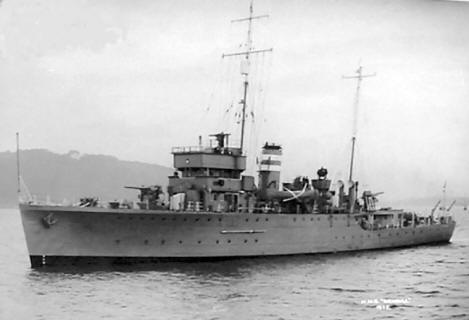This article originally appeared in Wessex Chronicle Volume 16 Issue 1 (Spring 2015)
Wessex has always been proud of her seafaring tradition, one that asserts King Alfred to have founded the Royal Navy, and the names of Sir Francis Drake and Sir Walter Raleigh are known throughout the world. One lesser-known naval innovation from Devon, however, is HMS Seagull (above), built in Devonport in 1937, and subsequently adopted by the town of Christchurch after a “Warship Week” campaign by the National Savings Bank.
She was the first Royal Navy ship to be built entirely without rivets, all joints being welded throughout. As Britain mobilised for war, the advantage that this offered in terms of speed was enormous, and a very important innovation at a time when the fleet needed to be very much bigger than it was.
Given the pennant number N85 initially, which was then changed to J85 (J being the pennant code for a minesweeper), the Seagull was a Halcyon-class minesweeper, one of 21 such ships that served during World War 2 at Dunkirk, in the Mediterranean, and on the Arctic Convoys, which is where the Seagull served as an escort.
She started her career in rough weather trials in Icelandic waters in 1938, and once her hardiness and durability in the cold arctic waters had been established, spent the first two years of the war based at Scapa Flow in the Orkney Islands. In 1941, she joined the Second Escort Group based at Derry, Ireland, from which she joined Arctic Convoy PQ2 from Liverpool to Archangelsk, one of 21 convoys she helped escort.
One of the lowlights of her illustrious naval career came in 1942, when she was involved in the accidental sinking of a Polish submarine, the ORP Jastrząb (Hawk). The allied sub was mistaken for a German craft, and the Seagull, along with the HMS St Albans, bombed her with depth charges, scuttling her and killing five crew members. A court of enquiry found that the Jastrząb had been out of position by over 100 nautical miles, but the Seagull’s commander, Charles Harington Pollock, was nonetheless found guilty of ignoring identification markings.
HMS Seagull escorted her last Arctic Convoy, RA57 from Kola Inlet to Loch Ewe, in March 1944. Subsequently, she formed part of the 1st Minesweeping Flotilla during Operation Neptune; that is, the Normandy landings. Admiral Sir Bertram Ramsay, Commander-in-Chief of the Allied Naval Expeditionary Force, had written in his diary that “There is no doubt that the mine is our greatest obstacle to success”, and so the importance of the minesweepers’ work is hard to overstate. Seagull and seven other Halcyons swept channel 9 into Sword Beach. Between them, their total haul of mines in the three months after D-Day was 10% of the total number of mines swept in all theatres from the beginning of the war up to that point.
Mines continued to plague British waters long after the end of World War 2. Following her valiant service on D-Day and in the period immediately following it, Seagull was given a refit and continued as a survey ship in the waters between Britain and the continent until 1951, when she was returned to Devonport for disposal.

